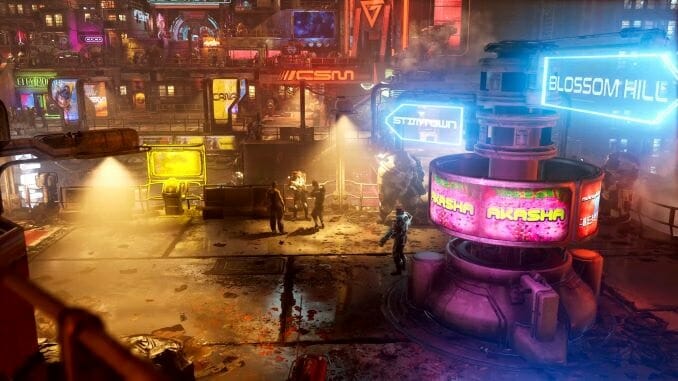
As your cyberpunk operative moves through the planet Veles, the camera cuts away from them. It lingers on aliens and humans milling about at a bar or loitering in squalor. The standard isometric camera shifts to a profile view or expands to show the layered scale of its planetary city. The Ascent clearly wants the player to feel embodied, to feel like a small part of a larger community. Veles is dense, drenched in neon, hundreds of people hover in almost every area. It feels material as hundreds of wires string themselves on the street, snaking down to the power plants below the city. This is all surface shimmer. The deeper you go into Veles, the more districts you find, the more it feels like a hollow world. The Ascent is undeniably shaped by nearly every piece of cyberpunk media from years past. However, there is little reflection in the way it pulls neon and metal from its ancestors. It would be inaccurate and reductive to say that The Ascent does nothing with its plethora of sci-fi influences. What it does, though, is pretty damn boring.
To its credit, The Ascent doesn’t waste a lot of time. The opening cutscene zooms into “The Ascent Group arcology,” a miniature city within the massive planetary metropolis. Stacked white text reveals that you are an indentured servant, an “indent,” owned by a corporation, The Ascent Group, in exchange for transport to Veles. Then you leap right into the muck, restoring plumbing to your section of the city. However, the complete collapse of The Ascent Group interrupts your routine and you’ll have to dive into every part of the city to rebuild a life. Right away, the game gets convoluted with proper nouns and codex entries. You get notifications for every new location, character, or enemy. Luckily it’s all pretty snappy and the broad strokes are familiar. You are an exploited worker, caught between vast corporate forces, making your way through the only way you know how, through the barrel of a gun.
The thing is, all that immediate world building is simply backdrop for a rote twin-stick shooter. Though your Indent can gain augmentations and skill points and “tacticals” all of it has everything to do with shooting. The combat never really feels expressive, but it does feel like it can be optimized. Skill points upgrade critical hit chance or let you dodge slightly faster. The only ability outside of shooting is hacking, which is paper thin, the vestigial limb of what cyberpunk games should be. Though the game gestures at themes of labor and spends a lot of time establishing setting, it is all in service of simple shooter power fantasy. It’s not alone. Open world games from Assassin’s Creed to Watch Dogs glory in this kind of optimization. These are games not really about exploration or freedom, but about mastering a specific kind of play and conquering the world. The Ascent’s lively setting and large crowds are not enough to distract from the fact that it is an extremely normal videogame.
However, normal videogames are about labor by default. Though your indent is an extreme example of exploitation, playing The Ascent is an exercise in being an idealized subject of liberal capitalism. You quite literally ascend through the dynamics of class, elevating yourself above poverty through your own power and efficiency. In a sense, videogames can serve as an alleviation of capitalism’s harshness. Enough hard work will get you in a better place and allow you financial freedom. The Ascent undoubtedly is just another example of this. However, it gains a darkly funny edge in context. You, and those you kill, are all just workers. Your ascension comes with the death of thousands of others. Despite its issues, it would be silly to say that The Ascent doesn’t do anything with its aesthetics.
Still, this gesture at meaning is just that, a gesture. When the game doesn’t allow any interaction with its world except the violent and economic, its hard wires become paper thin panoramas. It extremely does not help that The Ascent wholeheartedly imports orientalist aesthetics without reflection. On this alien world, East Asian writing is everywhere, cherry blossoms dot the balconies of the ultra rich, and katana wielding mercs obsessed with honor guard pagoda palaces. It is nothing but flavoring to make a sci-fi setting more “exotic” and to align it with the genre’s old guard. Tying an exploitative society directly to stereotypically Asian aesthetics is racist, and there has been plenty of criticism, popular and otherwise, that has pointed this out. There is no reason for any game in 2021, even a smallish one from a Swedish team, to be so orientalist.
That thoughtlessness is reflective of the game as a whole. It discusses labor and capitalism without bite, regurgitates cyberpunk without reflection, and offers only a thinly satisfying shooter at its core. It’s easy to see how this game has become a small hit. It looks good at first glance and is likely significantly more fun with friends. Still, every thrill that The Ascent offers, you can find somewhere else with more honesty and more heart.
Grace Benfell is a queer woman, critic, and aspiring fan fiction author. She writes on her blog Grace in the Machine and can be found @grace_machine on Twitter.